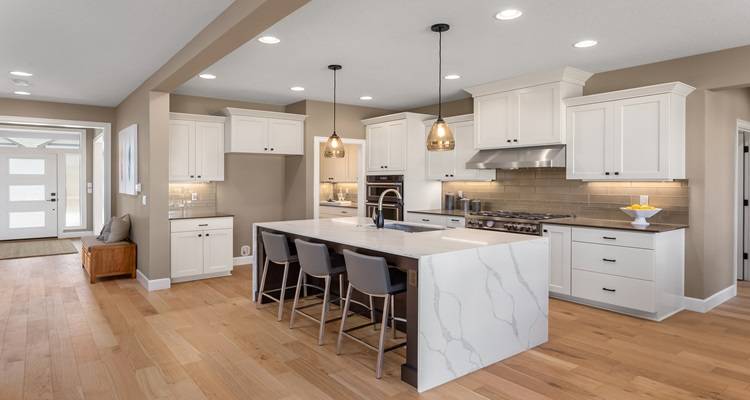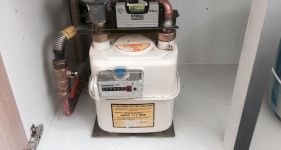Underfloor Heating Cost
- The average underfloor heating installation cost is around £800.
- This type of job will typically take between 1 to 2 days to complete.
- NEW! Our underfloor heating cost calculator, which gives you a quick and easy estimate for how much it costs to install underfloor heating in 2026.
- A breakdown of how much underfloor heating costs per square metre for wet and electric installations in the UK.
- Additional jobs you might need to budget for, which might impact the total underfloor heating cost you're quoted.
- Advice shared by tradespeople on MyJobQuote.
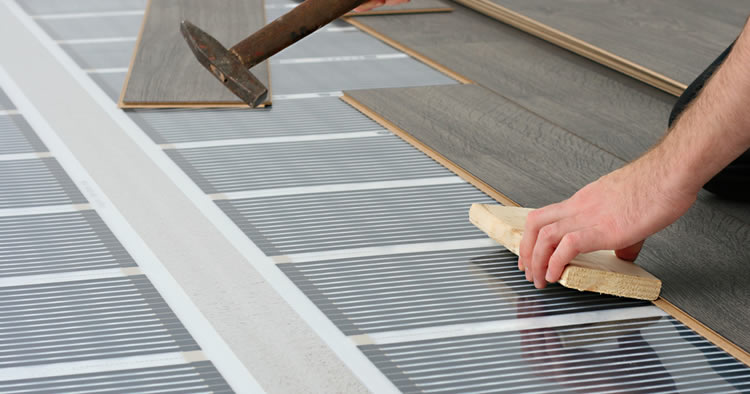
£800
Table of Contents
- How Much Does Underfloor Heating Cost?
- Electric vs Wet Underfloor Heating: Which Fits Your Project?
- What's The Best Flooring For Underfloor Heating?
- Best Rooms for Underfloor Heating
- Additional Underfloor Heating Costs
- Should I Have Underfloor Heating Installed?
- Can You Install Underfloor Heating Yourself?
- Checklist: How To Find and Hire an Underfloor Heating Specialist in the UK
- FAQs
Video Overview: How Much Is Underfloor Heating?
How Much Does Underfloor Heating Cost?
Underfloor heating has become a popular alternative to conventional radiators in UK homes — especially in luxury bathroom renovations, kitchen extensions, and loft conversions. It can be installed under almost any type of flooring — including stones, wood, tiles, and carpets.
There are two different types of underfloor heating you can get.
Let's take a look at these (and their typical costs) below:
Electric Underfloor Heating Cost
Electric underfloor heating systems use a network of wires running in a mat which is fitted under the surface of the floor. They warm the floor, but are not as good at heating the room, so are best installed in smaller rooms (e.g., bathrooms).
In 2026, electric underfloor heating costs between £40 and £90 per m² to get installed by an experienced professional. (This estimate includes materials and labour.)
Smaller rooms (e.g., downstairs toilets or ensuites) will typically land at the higher end of this range. Larger rooms will be towards the lower end of this range, as it works out more efficiently for the tradesperson to fit.
Below are a few quick cost examples for different types of rooms:
| Room Type and Size (m²) | Average Cost |
|---|---|
| Small Downstairs Toilet (2m²) | £160 – £180 |
| Ensuite Bathroom (4m²) | £240 – £300 |
| Medium Kitchen (12m²) | £600 – £900 |
| Conservatory (14m²) | £630 – £980 |
| Living Room (20m²) | £800 – £1,200 |
Electric Underfloor Heating Systems Are Best For: Retrofits of smaller rooms (e.g., downstairs bathrooms, ensuites, small extensions).
Main Tradesperson Required: Electrician
Pros
- ✔ Electric underfloor heating installation costs are lower than a wet underfloor heating system.
- ✔ Typically involves limited additional costs.
- ✔ Minimal impact on the height of the floor.
Cons
- ✖ Electric underfloor heating running costs are higher than a wet underfloor heating system.
- ✖ Not as efficient at heating larger rooms (e.g., living rooms).
Wet Underfloor Heating Cost
Wet uses a network of pipes to run hot water from the boiler, which then radiates heat through the floor and into the room. These wet underfloor systems are much more efficient than electric underfloor systems — and can even be more efficient than conventional radiators.
In 2026, wet underfloor heating costs between £100 and £190 per m² to get installed by an experienced professional. (This estimate includes materials and labour.)
Below are a few quick cost examples for different types of rooms:
| Room Type and Size (m²) | Average Cost |
|---|---|
| Small Downstairs Toilet (2m²) | £340 – £380 |
| Ensuite Bathroom (4m²) | £600 – £720 |
| Medium Kitchen (12m²) | £1,200 – £1,500 |
| Conservatory (14m²) | £1,300 – £1,600 |
| Living Room (20m²) | £1,800 – £2,200 |
Wet Underfloor Heating Systems Are Best For: Major renovations of large areas (or an entire property), as well as new builds.
Main Tradesperson Required: Heating Engineer
Pros:
- ✔ Wet underfloor heating running costs are lower than those of an electric underfloor heating system.
- ✔ More efficient at heating larger rooms (e.g., living rooms).
Cons:
- ✖ Wet underfloor heating installation costs are higher than an electric underfloor heating system.
- ✖ Might necessitate a boiler replacement (~£2,000).
- ✖ Heats up more slowly than an electric underfloor heating system.
- ✖ Typically requires extensive new piping to connect to the boiler.
Underfloor Heating Costs Per m²
The table below summarises how much underfloor heating costs per m² in the UK for these two different types of systems.
As this shows, a factor that significantly impacts the cost to install underfloor heating is whether it's a new build or you're retrofitting an older property.
| Job Description | Cost Per m² |
|---|---|
| Electric underfloor heating (new build) | £40 – £80 |
| Electric underfloor heating (older home) | £50 – £90 |
| Water underfloor heating (new build) | £100 – £140 |
| Water underfloor heating (older home) | £150 – £190 |
Electric vs Wet Underfloor Heating: Which Fits Your Project?
The choice between electric and wet underfloor heating systems often comes down to the scale of the project that you're planning.
In the UK, electric underfloor heating is a much more popular choice because it's more suitable for retrofits (i.e., when homeowners are upgrading an existing room). They're nowhere near as disruptive as installing a piped underfloor heating system and an affordable (yet luxurious!) upgrade option when renovating a single room.
However, wet underfloor heating systems are the more common choice for new builds or when homeowners are undertaking major renovations (e.g., single-storey extensions).
But why is that?
- Wet underfloor heating systems are powerful enough to 100% replace radiators (which is especially valuable for open-plan renovations).
- The installation of underfloor heating can be built into your renovation plans, so it's nowhere near as disruptive as it otherwise would be.
- Wet underfloor heating running costs are lower, so it's more cost-efficient in the long run (especially with rising energy prices in the UK).
So, while electric underfloor heating systems might be the go-to choice for smaller renovations (e.g., luxurious ensuite upgrades), wet underfloor heating systems are typically the better option if you're planning a larger renovation.
Underfloor Heating Cost Calculator
How to Find an Underfloor Heating Installer
MyJobQuote is the simplest, easiest, and fastest way to find an underfloor heating installer near you.
All you need to do is:
- Head over to our quote form.
- Give us a few details about what you're after.
- Sit back and wait for local tradespeople to get in touch to arrange visits.
This is the perfect way to get multiple quotes from local underfloor heating specialists — and get the best price for your job.
What's The Best Flooring For Underfloor Heating?
Not all floorings are made the same - and not all conduct heat in the same way, which means your underfloor heating can perform better (and worse) under some flooring types.
The bottom line: The best underfloor heating flooring pairings are those with good thermal conductivity and a low tog rating.
What's a "tog rating"?
You'll be aware of tog ratings in duvets, but they're present in flooring materials, too.
- Low tog ratings of 0.1 to 0.5 are best for underfloor heating pairing as heat passes through it easily.
- High tog ratings of 2+ are less efficient for underfloor heating as the heat gets trapped.
Let's take a closer look at common flooring types and their compatibility:
Tiled Floors (Stone, Ceramic, Porcelain)
Tile floors have a tog rating of 0.1 to 0.2, making them a great match for underfloor heating.
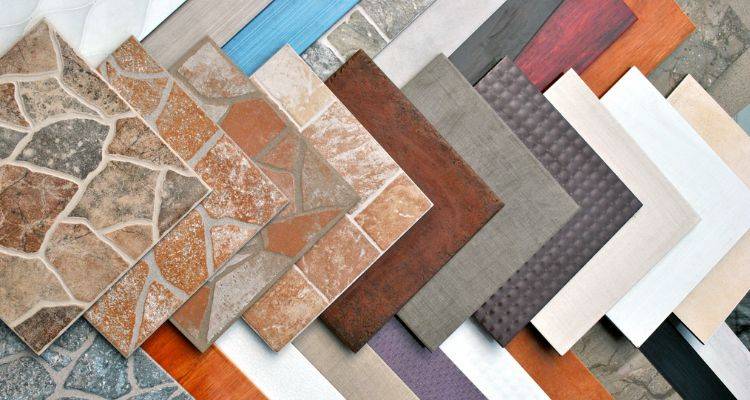
Pros
- ✔ Great for transfering heat
- ✔ Durable and water-resistant
Cons
- ✖ Can be cold when underfloor heating isn't on
- ✖ May develop cracks if the subfloor isn't stable
Luxury Vinyl Tile (LVT)
LVT has a tog rating of 0.3 to 0.5. While this isn't as low as tile floors, it's still within the optimal range for compatibility.
Pros
- ✔ Lots of design choices and colours for different home decor
- ✔ Comfortable to walk on
Cons
- ✖ Surface may warp if the temperature is too high, or the LVT isn't underfloor heating rated
- ✖ Must have a specialist underfloor heating adhesive
Engineered Wood
Engineered wood flooring comes with a tog of 0.5 to 1, which means some flooring designs can be too thick to achieve optimum heat transfer.
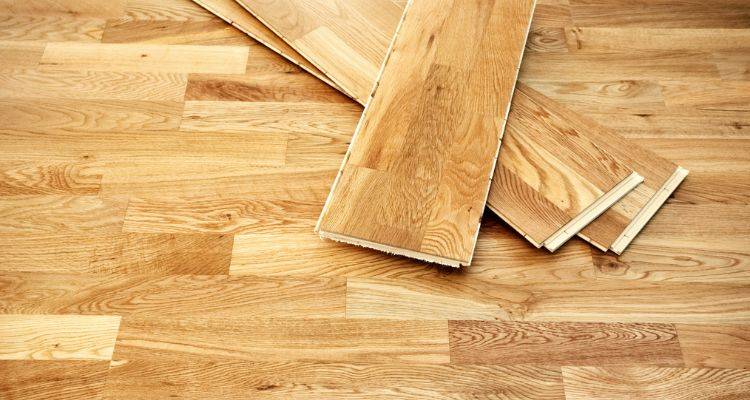
Pros
- ✔ Gives a homely, natural aesthetic
- ✔ More forgiving than hardwood flooring
Cons
- ✖ If the flooring is too thick, the heat won't transfer as well
- ✖ Can be sensitive to excessively high temperatures
Laminate
Laminate flooring rates between 0.5 to 0.7. You'll need to choose an underfloor heating compatible variant for best results.
Pros
- ✔ Affordable and easy to install yourself
- ✔ Easy to clean and maintain
Cons
- ✖ Lifespan is typically shorter than other flooring types
- ✖ If the laminate isn't rated for underfloor heating, it can warp over time
Carpet
Carpet has a high tog rating of around 2.5, making it less suitable for underfloor heating than other flooring options.

Pros
- ✔ Warm, cosy feel
- ✔ Comfortable underfoot
Cons
- ✖ Thick carpets aren't suitable for underfloor heating as they trap the heat
- ✖ Not suitable for all rooms
Best Rooms for Underfloor Heating
Struggling to figure out which room underfloor heating is right for? Here's what you need to know at a glance:
- Best rooms for underfloor heating - Bathrooms/ensuites, kitchens, and open-plan living areas.
- Less ideal rooms for underfloor heating - Rooms with thick carpet (higher than 2 tog rating), small cloakrooms, and rooms you rarely use.
Now we've got a broad understanding, let's go deeper and look at different scenarios based on your goals:
If You Want To Optimise Comfort
Improving your home's comfort is a great motivator for installing underfloor heating. Instead of cold tiles, you can replace them with pre-warmed stone to ease dark and cold early mornings.
For example: Installing underfloor heating in your home's bathroom/ensuite can improve your morning and evening routines, reducing the shock of cold floors underfoot.
If You Want Better Heating Control
Ideal spaces for underfloor heating are large, open-plan living areas.
In these rooms, you can zone your underfloor heating so you can heat specific spots at specific times.
For example: You have underfloor heating installed in your open-plan living/kitchen room. You can choose to heat up the kitchen area during breakfast, and heat the living area later in the day when you return from work.
If You Want To Reduce Your Energy Bills
Where possible, it's more cost-effective to install underfloor heating during construction periods instead of having it retrofitted.
For example: If you're buying a new build property, and you choose to add underfloor heating during the building phase. This will have a knock-on effect by lowering your heating bills in the long term as you won't be entirely reliant on radiators for warmth.
Additional Underfloor Heating Costs
When estimating the total cost of an underfloor heating installation, you might need to budget for some additional jobs.
Let's take a quick look at these below:
New Flooring
While it's sometimes possible to reuse your current flooring when getting underfloor heating installed in an existing space, most homeowners take the opportunity to install new flooring.
And in new builds (e.g., extensions), you'll always need to budget for this on top of the underfloor heating costs covered above.
Flooring costs vary significantly depending on the type of flooring you'd like to get. Overall, you're looking at somewhere between £15 and £100 per m².
The table below gives a better idea of flooring costs for 3 of the materials that are most popular among homeowners getting underfloor heating installed.
| Flooring Type | Typical Price Range |
|---|---|
| Ceramic / Porcelain Tiles | £40 – £70 per m² |
| Luxury Vinyl Tile (LVT) | £30 – £50 per m² |
| Engineered Wood | £50 – £80 per m² |
What type of flooring does not go well with underfloor heating?
Moving or Removing Radiators
If you're planning to install underfloor heating in a room that already has radiators, then you'll need to budget to move or remove them.
The average cost of moving a radiator is around £275 per radiator.
If you're rather just remove the radiators, then you'll need to budget around £200 per radiator.
We're planning to install underfloor heating in our kitchen. Do we still need a radiator?
Boiler Relocation
You may have to move your existing boiler to a different location for ease of access, especially if you're installing a wet system into your property.
The average boiler relocation cost is around £725.
New Boiler
If you're opting for a wet underfloor heating system (i.e., connected to your boiler), then it's possible you may need to upgrade your boiler to accommodate the additional demand placed on it.
This is something you'll want to clarify with the professional installer when getting a quote, as the cost of installing a new boiler is around £2,400.
Should I Have Underfloor Heating Installed?
To answer this, let's look at the main advantages of underfloor heating:
- It can be one of the most cost-efficient ways to heat your home.
- Electric underfloor heating mats are simple to DIY install, although you will need an electrician for wiring.
- Underfloor heating can offer a space-saving alternative to radiators.
- Low-maintenance heating option if installed correctly.
For balance, let's consider the negatives of underfloor heating:
- Underfloor heating can take longer to heat up than conventional radiators.
- Not suitable with all flooring types (e.g., those with high tog ratings like thick carpet).
- Carries a high upfront cost.
- May require bigger plumbing upgrades, such as a new boiler.
Can You Install Underfloor Heating Yourself?
Wet underfloor heating systems are not DIY friendly.
Installing them will, at the very least, require some assistance from a heating engineer. With a system which is connected to your main boiler, it’s simply not worth chancing it and doing it on your own, so always consult a local heating engineer or underfloor heating company to advise you before taking on this job.
A survey carried out by a professional will help you select the best underfloor heating system and ensure your boiler can support the additional heating system. However, DIY electric underfloor systems using heat mats are much simpler and cheaper to install.
You will still need an electrician to connect the power up to your heating system, but for a typical bathroom, the total cost for DIY electric underfloor heating can be under £500. For those who are very confident in their skills, there are also DIY wet underfloor heating kits.
These full kits include a pump, valves, thermostats and pipework to heat around 20 square metres. If you did most of the work DIY and just hired a plumber or heating engineer for the important bits, you could have a wet underfloor heating system in your bathroom for under £1,000.
As we need a new central heating system, should we switch to underfloor heating rather than replace the radiators? What's more cost-effective in your opinion?
Radiators are cheaper but take up wall space and generally cost more to run due to higher flow temperatures"
Checklist: How To Find and Hire an Underfloor Heating Specialist in the UK
When the time comes to hire an underfloor heating specialist, here's what we suggest:
- Gather at least 3 quotes from local underfloor heating fitters to get an idea of prices.
- Ask for an itemised breakdown of costs, being sure to clarify any added waste removal fees.
- Take a look at the trader's customer reviews and photos/videos of their past work - does it fit your vision?
- Make sure the installer has experience with your type of underfloor heating (e.g., wet or electric, or installed during construction or retrofitted)
- Remember to ask about warranties and guarantees on parts and labour.
FAQs
What are the downsides to underfloor heating?
Can underfloor heating be used as a whole-house heating system?
A heat loss calculation needs to be carried out to determine how much heating is needed, and this is normally carried out by an architect or a heating engineer.







